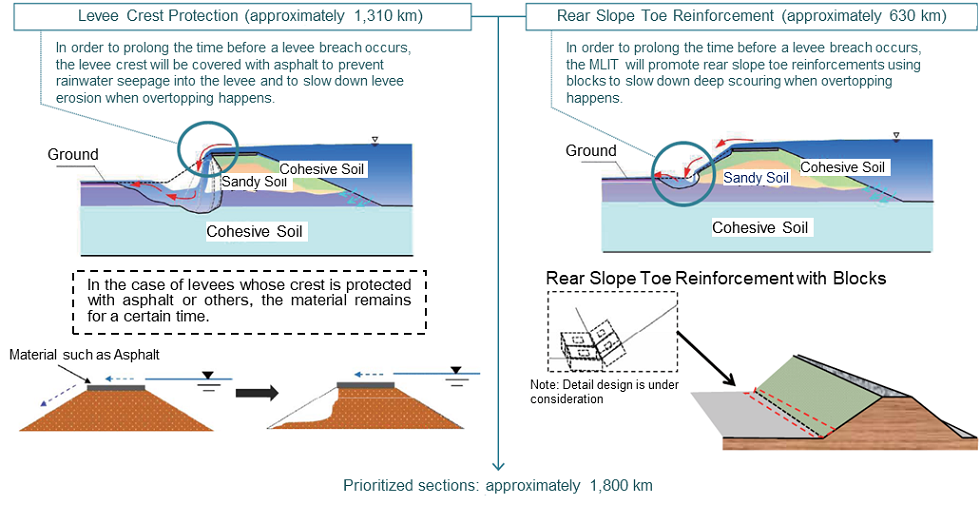- |
- Top
- |
- Points
- |
- Non-Structural Measures
- |
- Structural Measures
- |
- Communities
- |
- Japanese
- |


The MLIT will promote structural measures for crisis management to minimize damage when flooding occurs, in addition to structural measures for outflow prevention
Structural Measures for Outflow Prevention
|
|
|
|
Levees will be improved beginning with
high-priority sections
to prevent overflow and seepage.
|
The MLIT will continue to work on structural measures for outflow prevention
to enhance safety against seepage and erosion and to increase discharge capacity. For the length of 1,200 km of high-priority sections, the improvement measures are planned to be completed in about 5 years, by 2020. |

|
|

Example 1

Piping / Slope Slip
-> Leakage Prevention
including seepage
-> Leakage Prevention
including seepage
Length = approximately 360 km
(seepage prevention on the levee)
Length = approximately 330 km
(piping prevention)
(seepage prevention on the levee)
Length = approximately 330 km
(piping prevention)
- Risky sections of levee breach due to seepage etc.
- Potential sections of piping such as former riverbed
- Potential sections of piping such as former riverbed

Example 2

Lack of Flow Capacity
-> Levee Improvement and
Channel Excavation
-> Levee Improvement and
Channel Excavation
Length = approximately 760 km
- Incomplete sections for target capacity due to such reasons as lower levee height
(to be improved keeping up-and-downstream balance)

Example 3

Erosion / Scour
-> Erosion Control and
Scour Prevention
-> Erosion Control and
Scour Prevention
Length = approximately 110 km
- Dangerous sections at risk of riverbank erosion and revetment failure
-> Prioritized sections: approximately 1,200 km
Structural Measures for Crisis Management
|
|
|
|
The MLIT will promote reinforcements to prolong the time before a levee is breached, even when overflow occurs.
|
For the 1,800 km section at high where levee improvement cannot be conducted while keeping an up-and-downstream balance,
the MLIT will promote reinforcements to prolong the time before a levee is breached. This will be completed in about 5 years, by 2020. |

|
|